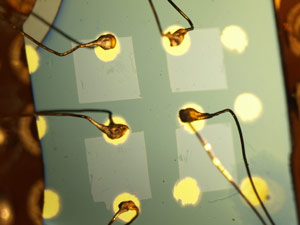- News
9 October 2013
Gallium oxide/silicon carbide heterojunction yields fast, high-sensitivity detection of UVC light
Researchers at Japan’s Ishinomaki Senshu University have developed a new photodiode that can detect in just milliseconds high-energy deep-ultraviolet (UVC) light, which is powerful enough to break the bonds of DNA and harm living creatures (‘Deep ultraviolet photodiodes based on β-Ga2O3/SiC Heterojunction’, Shinji Nakagomi, Toshihiro Momo, Syuhei Takahashi and Yoshihiro Kokubun, Applied Physics Letters).
Although this radiation does not normally reach the Earth’s surface, it can leak through to just below the hole in the ozone layer. Monitoring this radiation is a way of tracking the hole in the ozone layer, and photodiodes that measure UVC are also used as flame sensors and for communication in space.
Now, Shinji Nakagomi and colleagues have built a new kind of photodiode that can detect the whole range of UVC light while remaining insensitive to visible light from the sun - two features that have eluded designers of current devices. By being ‘solar blind’, photodiodes are more sensitive to the UVC range and are thus more useful.
Some photodetectors consisting of vacuum tubes on sale, but they have short lifetimes and are relatively large and unwieldy. Currently, many photodetectors are instead based on a p-n junction photodiode.
Other photodiodes made from materials like aluminum nitride and diamond are sensitive only to a limited range of UVC light. But recently, gallium oxide has shown promise because it's sensitive to the entire UVC range and is solar blind. The problem, however, is that it is difficult to make p-type gallium oxide.
Instead of a photodiode based on a conventional p-n junction, the researchers fabricated one based on a heterojunction, incorporating two different semiconductor materials: β-Ga2O3 gallium oxide (with an energy bandgap of 4.9eV) and 6H-SiC silicon carbide (with an energy bandgap of 3.02 eV). Specifically, A thin (200nm) layer of β-Ga2O3 was prepared on a p-type 6H-SiC substrate through gallium evaporation in oxygen plasma.
 Picture: Ishinomaki Senshu University’s Ga2O3/SiC heterojunction DUV photodiode.
Picture: Ishinomaki Senshu University’s Ga2O3/SiC heterojunction DUV photodiode.
The heterojunction device showed good rectifying properties. Under reverse bias, the current increased linearly with increasing deep-UV light intensity. The responsivity of the photodiode was highest to deep-UV light below a wavelength of 260nm.
The team also found that the device responds quickly to UV light - within milliseconds - and has little dark current (the intrinsic electrical current flowing through the device even in the absence of light), which is key for photodiode sensitivity.
“The most important aspect about our device is that it is based on a heterojunction between gallium oxide and silicon carbide,” says Nakagomi. “This gallium oxide and silicon carbide photodiode is promising for the detection of UV light,” he concludes.
http://apl.aip.org/resource/1/applab/v103/i7/p072105_s1


